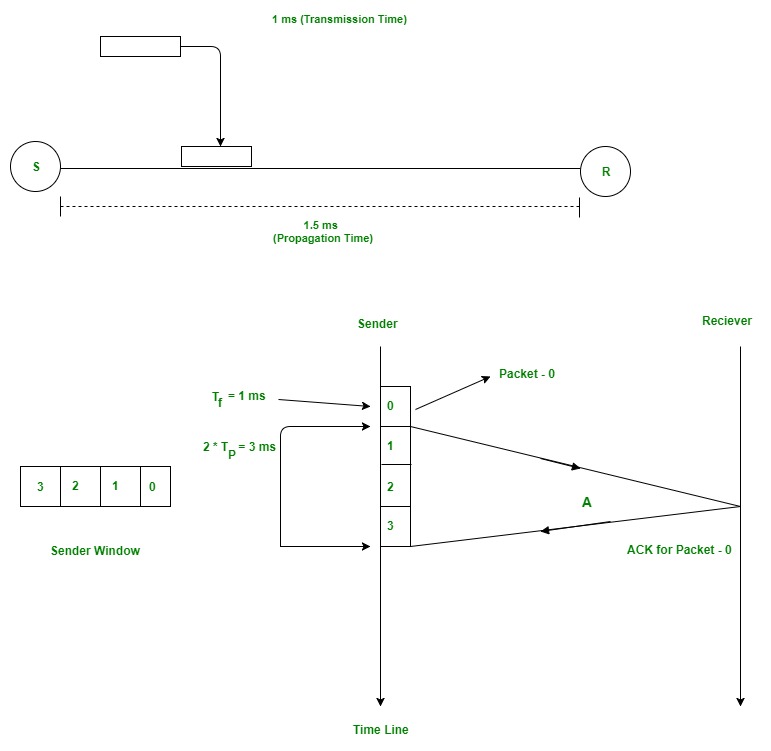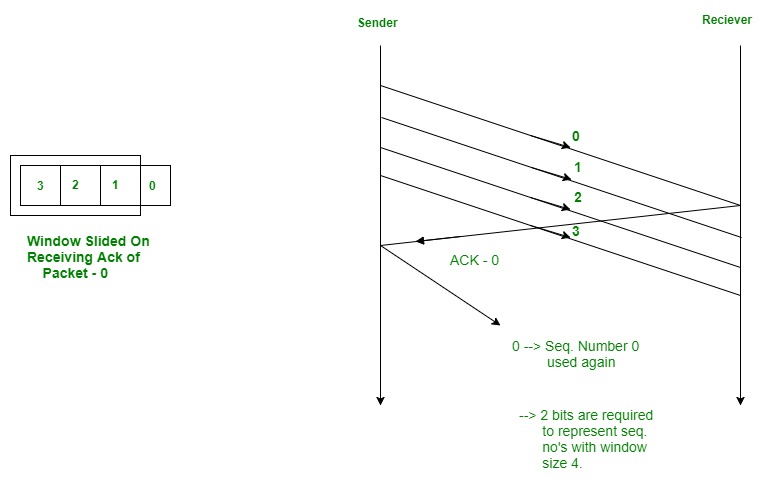Sliding Window Protocol | Set 1 (Sender Side)
Last Updated :
26 Feb, 2024
The Stop and Wait ARQ offers error and flow control but may cause big performance issues as the sender always waits for acknowledgment even if it has the next packet ready to send. Consider a situation where you have a high bandwidth connection and propagation delay is also high (you are connected to some server in some other country through a high-speed connection), you can’t use this full speed due to limitations of stop and wait.
Sliding Window protocol handles this efficiency issue by sending more than one packet at a time with a larger sequence number. The idea is the same as pipelining in architecture.
Terminologies Related to Sliding Window Protocol
Transmission Delay (Tt) – Time to transmit the packet from the host to the outgoing link. If B is the Bandwidth of the link and D is the Data Size to transmit
Tt = D/B
Propagation Delay (Tp) – It is the time taken by the first bit transferred by the host onto the outgoing link to reach the destination. It depends on the distance d and the wave propagation speed s (depends on the characteristics of the medium).
Tp = d/s
Efficiency – It is defined as the ratio of total useful time to the total cycle time of a packet. For stop and wait protocol,
Total time(TT) = Tt(data) + Tp(data) +
Tt(acknowledgement) + Tp(acknowledgement)
= Tt(data) + Tp(data) + Tp(acknowledgement)
= Tt + 2*Tp
Since acknowledgements are very less in size, their transmission delay can be neglected.
Efficiency = Useful Time / Total Cycle Time
= Tt/(Tt + 2*Tp) (For Stop and Wait)
= 1/(1+2a) [ Using a = Tp/Tt ]
Effective Bandwidth(EB) or Throughput – Number of bits sent per second.
EB = Data Size(D) / Total Cycle time(Tt + 2*Tp)
Multiplying and dividing by Bandwidth (B),
= (1/(1+2a)) * B [ Using a = Tp/Tt ]
= Efficiency * Bandwidth
Capacity of link – If a channel is Full Duplex, then bits can be transferred in both the directions and without any collisions. Number of bits a channel/Link can hold at maximum is its capacity.
Capacity = Bandwidth(B) * Propagation(Tp)
For Full Duplex channels,
Capacity = 2*Bandwidth(B) * Propagation(Tp)
Concept of Pipelining
In Stop and Wait protocol, only 1 packet is transmitted onto the link and then sender waits for acknowledgement from the receiver. The problem in this setup is that efficiency is very less as we are not filling the channel with more packets after 1st packet has been put onto the link. Within the total cycle time of Tt + 2*Tp units, we will now calculate the maximum number of packets that sender can transmit on the link before getting an acknowledgement.
In Tt units ----> 1 packet is Transmitted.
In 1 units ----> 1/Tt packet can be Transmitted.
In Tt + 2*Tp units -----> (Tt + 2*Tp)/Tt
packets can be Transmitted
------> 1 + 2a [Using a = Tp/Tt]
Maximum packets That can be Transmitted in total cycle time = 1+2*a Let me explain now with the help of an example. Consider Tt = 1ms, Tp = 1.5ms. In the picture given below, after sender has transmitted packet 0, it will immediately transmit packets 1, 2, 3. Acknowledgement for 0 will arrive after 2*1.5 = 3ms. In Stop and Wait, in time 1 + 2*1.5 = 4ms, we were transferring one packet only. Here we keep a window of packets that we have transmitted but not yet acknowledged.  After we have received the Ack for packet 0, window slides and the next packet can be assigned sequence number 0. We reuse the sequence numbers which we have acknowledged so that header size can be kept minimum as shown in the diagram given below.
After we have received the Ack for packet 0, window slides and the next packet can be assigned sequence number 0. We reuse the sequence numbers which we have acknowledged so that header size can be kept minimum as shown in the diagram given below. 
Minimum Number of Bits For Sender Window (Very Important For GATE)
As we have seen above,
Maximum window size = 1 + 2*a where a = Tp/Tt
Minimum sequence numbers required = 1 + 2*a.
All the packets in the current window will be given a sequence number. Number of bits required to represent the sender window = ceil(log2(1+2*a)). But sometimes number of bits in the protocol headers is pre-defined. Size of sequence number field in header will also determine the maximum number of packets that we can send in total cycle time. If N is the size of sequence number field in the header in bits, then we can have 2N sequence numbers. Window Size ws = min(1+2*a, 2N) If you want to calculate minimum bits required to represent sequence numbers/sender window, it will be ceil(log2(ws)). In this article, we have discussed sending window only. For receiving window, there are 2 protocols namely Go Back N and Selective Repeat which are used to implement pipelining practically. We will be discussing receiving window in set 2.
Types of Sliding Window Protocol
There are two types of Sliding Window Protocol which include Go-Back-N ARQ and Selective Repeat ARQ:
Go-Back-N ARQ
Go-Back-N ARQ allows sending more than one frame before getting the first frame’s acknowledgment. It is also known as sliding window protocol since it makes use of the sliding window notion. There is a limit to the amount of frames that can be sent, and they are numbered consecutively. All frames beginning with that frame are retransmitted if the acknowledgment is not received in a timely manner. For more detail visit the page Go-Back-N ARQ.
Selective Repeat ARQ
Additionally, this protocol allows additional frames to be sent before the first frame’s acknowledgment is received. But in this case, the excellent frames are received and buffered, and only the incorrect or lost frames are retransmitted. Check the detailed explanation of Selective Repeat ARQ.
Advantages of Sliding Window Protocol
- Efficiency: The sliding window protocol is an efficient method of transmitting data across a network because it allows multiple packets to be transmitted at the same time. This increases the overall throughput of the network.
- Reliable: The protocol ensures reliable delivery of data, by requiring the receiver to acknowledge receipt of each packet before the next packet can be transmitted. This helps to avoid data loss or corruption during transmission.
- Flexibility: The sliding window protocol is a flexible technique that can be used with different types of network protocols and topologies, including wireless networks, Ethernet, and IP networks.
- Congestion Control: The sliding window protocol can also help control network congestion by adjusting the size of the window based on the network conditions, thereby preventing the network from becoming overwhelmed with too much traffic.
Disadvantages of Sliding Window Protocol
- Complexity: The sliding window protocol can be complex to implement and can require a lot of memory and processing power to operate efficiently.
- Delay: The protocol can introduce a delay in the transmission of data, as each packet must be acknowledged before the next packet can be transmitted. This delay can increase the overall latency of the network.
- Limited Bandwidth Utilization: The sliding window protocol may not be able to utilize the full available bandwidth of the network, particularly in high-speed networks, due to the overhead of the protocol.
- Window Size Limitations: The maximum size of the sliding window can be limited by the size of the receiver’s buffer or the available network resources, which can affect the overall performance of the protocol.
Frequently Asked Question on Sliding Window Protocol – FAQs
What is the Sliding Window Protocol?
Sliding Window Protocol is a method for sending numerous frames at once is the sliding window. In situations where steady and gradual data frame transmission is required, it manages the data packets between the two devices.
What are the components of the SWP?
Sliding Window Protocol are Sender Window , Reciever Window , Acknowledgement.
What happens when a packet is lost ?
If the packet is lost then the sender retransmit the packet again then receiver sends acknowledgement for the retransmitted packet.
Is out of ordering of packet allowed in Sliding window Protocol?
Out of order packet is not allowed in Sliding Window Protocol.
What is Round Trip Time?
The amount of milliseconds (ms) required for a network request to travel from a starting point to a destination and back again is known as the round-trip time (RTT).
Share your thoughts in the comments
Please Login to comment...